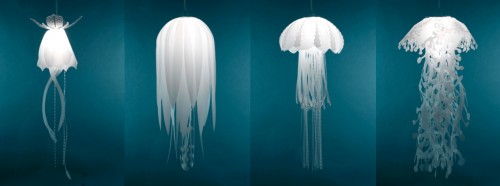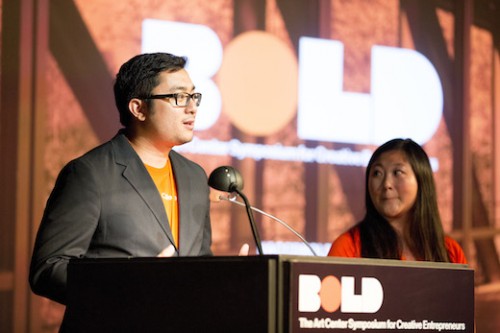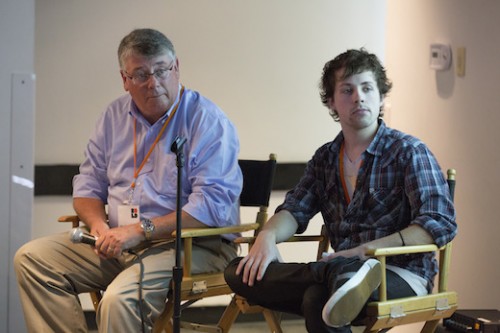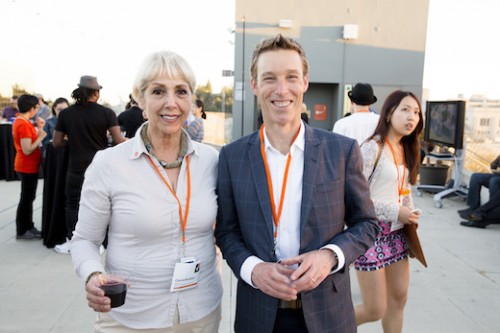
Medusae Collection by alumna Roxy Russell.
To be bold is to be confident and courageous, willing to take risks. It’s an essential trait shared by a powerhouse group of speakers assembled for BOLD: The Art Center Symposium for Creative Entrepreneurs, a one-day confab and networking event at the College’s Hillside Campus in Pasadena.
At once motivational and practical, the September 6th program offered personal testimonials from successful entrepreneurs, along with concrete skills and strategies that participants—multidisciplinary and multigenerational—could apply to their own creative endeavors.
The question on President Lorne M. Buchman’s mind as he greeted the full house: “What does it take to create a pertinent and relevant design education today? It used to be that the education was set up to get you a job. In 2014, you realize the student body is different, millennials are different. Something has shifted—and it has everything to do with entrepreneurship. There is a power, an insight, an energy, a compulsion even, to create innovation.”

Art Center Business Club member Martin Francisco, with the student organization’s co-founder and president, Pearlyn Lii.
Some of those millennials, current undergraduates, recently formed the Art Center Business Club, with academic advisor and faculty member Terry Stone; its energetic members served as volunteers throughout the conference. Meanwhile a range of ongoing course offerings at the College, plus initiatives like Dot Launch and curated Kickstarter and Indiegogo pages, support students interested in developing entrepreneurial ventures.
In art and design as in other sectors, innovation does not happen in a vacuum, but within a larger social and economic context, and sooner or later innovators confront challenges related to business and financing.
At BOLD, several workshops tackled the money question head on, including “Venture Funds, Angels, Friends and Family: Everything You Need to Know to Get Funded.” Panelists included James Iliff, the youthful co-founder of Survios, a virtual reality startup that aims to turn gaming into a full-body experience. Iliff’s partner in the venture is gaming entrepreneur Robert Nashak, an Art Center faculty member who co-teaches (with Terry Stone) the course Business 101 and also served as co-chair of BOLD. Their company recently completed a $4 million round of venture capital investment.

John Glanville and James Illif discuss funding for creative enterprises.
Iliff’s advice to anyone pitching their creative enterprise to potential funders: “It’s important to be yourself. It’s not like Alec Baldwin in Glengarry Glen Ross. It’s more like dating. If you’re too nervous, it may show that you’re not being yourself.”
For entrepreneurs aiming to up their game with the help of outside investors, the panelists emphatically recommended online resources like AngelList, Crunchbase and Arduino, along with the local bricks-and-mortar tech incubator, the Business Technology Center, a county office assisting start-up and early stage technology firms.
Over at the “Essential Guide to Galleries and Dealers” breakout session, panelist John Mills, a painter, had a different perspective. “All this discussion about the business side of art, it’s kind of disheartening. I’m an idealist. I want to make art because it gives my life meaning,” he said. “Ultimately you have to have a practice you believe in and that gives you joy.”
His fellow panelists stressed the importance of relationships—not from a what-can-you-do-for-me stance, but rather “people meeting in common interest and shared generosity, a sincere feeling of interconnecting purpose,” as L.A. gallerist Charlie James put it. In other words, finding and sustaining community.
Alum Nery Gabriel Lemus (BFA 07), represented by James’ gallery and joining him on the panel, agreed. “When I meet an artist whose work I like, I say ‘let’s swap studio visits.’ It’s not about me. I want to know about them and their work. I talk about my work only if someone asks me.” Lemus, who exhibits widely and also teaches art, was selected for the acclaimed Made in LA biennial at the Hammer Museum and the group show Fresh at MOCA, both in 2012.
Art Center aims to support its alumni over a lifetime of professional practice. Carole Boyajian (BFA 69) enjoyed a long career in interior and graphic design, and sales and marketing in the hospitality industry. Today she is back in her painting studio, and came to BOLD seeking advice and contacts to support her work as a fine artist.

Artist Carole Boyajian (BFA 69) at South Campus rooftop reception with Richard Weil, managing partner, The Design Accelerator
The growing creative economy
Introducing herself on a panel, independent entrepreneur Roxy Russell (BS 08) declared, only half-joking, “I sell jellyfish on the internet.”
It all started, she said, with a 2003 Art Center at Night class in lighting and illumination, which fed Russell’s passion for design and technology. She entered the Environmental Design degree program in 2004 and remembers, in 2007, “falling in love with the laser lab.” Along the way she was inspired by a guest artist visiting from Mexico (Jan Hendrix), who put natural patterns on mylar and vellum. In 2008 she hit upon the idea for biomorphic lamps whose shape and luminescence resemble jellyfish. The lamps became her thesis project “Current Seas,” based on the fragile ecosystems of the world’s oceans, which in turn launched her Medusae Collection of lamps; a portion of profits are donated to The Ocean Conservancy.
A native Californian, Russell recalls graduating into “a horrible economy” and the struggles that came with launching her small business manufacturing, marketing and distributing the lamps.
But everything changed after she posted her work on Art Center’s Behance page. “I checked the box that said they can use my images,” she said. “It was the best thing that ever happened to me.” An editor perusing the site discovered her work, and a slew of high-end international magazine coverage followed. She made a splash in social media as well: since this past February her lamps have garnered 85,000 likes on a popular science page. Also this year, the W hotel group placed a large order for their new spa retreat in the Maldives.
In retrospect, said Russell, “my initial capital investment in my business was Art Center tuition.”
While still recovering from the economic recession, California now leads the nation in terms of non-farm job growth. And that boast about Los Angeles being the creative capital of the world? It’s not just hype, said BOLD presenter Kimberly Ritter-Martinez, an economist at the L.A. County Economic Development Corporation and a principal contributor to the annual Otis Report on the Creative Economy. It’s a claim supported by national employment data.
And there’s more good news: Creative occupations offer higher levels of average income. One more reason, said Ritter-Martinez, “it’s important to support and harness the creative economy.”
One entrepreneur at a time, the number of independent contractors has increased dramatically over the past decade. In Los Angeles alone, the number of independent contractors has more than quadrupled, going from 215,000 in 2002 to 900,000 in 2012—many of whom ply their skills in art and design.
Spanning a wide array of creative professions, alumni entrepreneurs at BOLD included product designers like Markus Diebel (BS 94), and Joe Tan (BS 94), founders of Incase; graphic designers like Jon Van Hamersveld (BFA 64) and Talin Gureghian (BFA 89); photographers like Stella Kalinina (BFA 13) and symposium co-chair Yvette Roman (BFA 89); Illustration grad and “house portrait” artist Ellen Kirk (BFA 83); and current Illustration student Noah Minuskin, about to launch his own tattoo studio in downtown Los Angeles.
Read more: Creative entrepreneurs go BOLD-ly forth, getting to the heart of the matter









Awesome Blog post, very good info
Thank you Kristine Bowne, Yvette Roman, Robert Nashak, Terry Stone and thank you to the indefatigable Robbie Nock for producing a stellar event for the students and Alumni. This was such an exciting event for alumni and a spectacular way to start the Fall term for students. A wonderful chance for both alumni and students to interact and share their stories.
Thank you all!